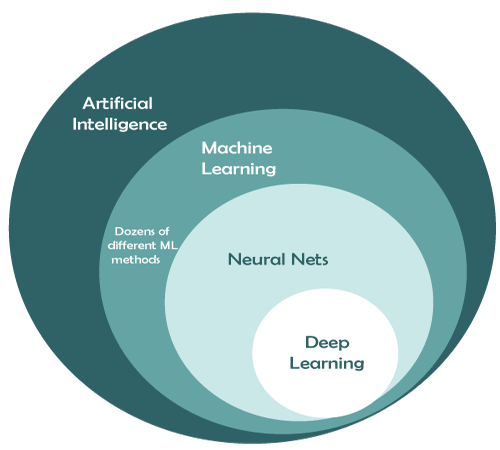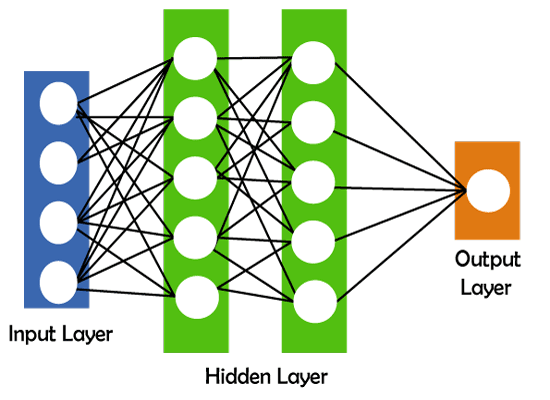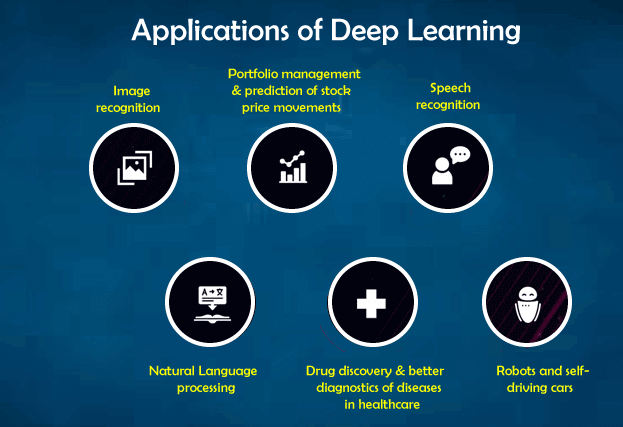Deep learning vs. Machine learning vs. Artificial IntelligenceDeep Learning, Machine Learning, and Artificial Intelligence are the most used terms on the internet for IT folks. However, all these three technologies are connected with each other. Artificial Intelligence (AI) can be understood as an umbrella that consists of both Machine learning and deep learning. Or We can say deep learning and machine learning both are subsets of artificial intelligence. As these technologies look similar, most of the persons have misconceptions about 'Deep Learning, Machine learning, and Artificial Intelligence' that all three are similar to each other. But in reality, although all these technologies are used to build intelligent machines or applications that behave like a human, still, they differ by their functionalities and scope. It means these three terms are often used interchangeably, but they do not quite refer to the same things. Let's understand the fundamental difference between deep learning, machine learning, and Artificial Intelligence with the below image. 
With the above image, you can understand Artificial Intelligence is a branch of computer science that helps us to create smart, intelligent machines. Further, ML is a subfield of AI that helps to teach machines and build AI-driven applications. On the other hand, Deep learning is the sub-branch of ML that helps to train ML models with a huge amount of input and complex algorithms and mainly works with neural networks. In this article, "Deep Learning vs. Machine Learning vs. Artificial Intelligence", we will help you to gain a clear understanding of concepts related to these technologies and how they differ from each other. So, let's start this topic with each technology individually. What is Artificial Intelligence (AI)?Artificial Intelligence is defined as a field of science and engineering that deals with making intelligent machines or computers to perform human-like activities. Mr. John McCarthy is known as the godfather of this amazing invention. There are some popular definitions of AI, which are as follows: "AI is defined as the capability of machines to imitate intelligent human behavior." "A computer system able to perform tasks that normally require human intelligence, such as visual perception, speech recognition, decision-making, and translation between languages." Types of Artificial Intelligence AI can be categorized mainly into 4 types as follows:
Application of Artificial Intelligent
We have taken a basic knowledge of Artificial Intelligence. Now, let's discuss the basic understanding of Machine Learning. What is Machine Learning?Machine Learning is defined as the branch of Artificial Intelligence and computer science that focuses on learning and improving the performance of computers/machines through past experience by using algorithms. AI is used to make intelligent machines/robots, whereas machine learning helps those machines to train for predicting the outcome without human intervention. How does Machine Learning work?Machine Learning uses algorithms and techniques that enable the machines to learn from past experience/trends and predict the output based on that data. 
However, firstly, machine learning access a huge amount of data using data pre-processing. This data can be either structured, semi-structured, or unstructured. Further, this data is fed through some techniques and algorithms to machines, and then based on previous trends; it predicts the outputs automatically. After understanding the working of machine learning models, it's time to move on to types of machine learning. Types of Machine LearningBased on the methods and techniques to teach machines, Machine Learning is categorized into mainly four types, which are as follows:
Steps involved in machine learningThere are 7 simple steps involved in machine learning as follows:
We have discussed machine learning and artificial intelligence basics, and it's time to move towards the basics of deep learning. What is Deep Learning?"Deep learning is defined as the subset of machine learning and artificial intelligence that is based on artificial neural networks". In deep learning, the deep word refers to the number of layers in a neural network. Deep Learning is a set of algorithms inspired by the structure and function of the human brain. It uses a huge amount of structured as well as unstructured data to teach computers and predicts accurate results. The main difference between machine learning and deep learning technologies is of presentation of data. Machine learning uses structured/unstructured data for learning, while deep learning uses neural networks for learning models. In machine learning, if a model predicts inaccurate results, then we need to fix it manually. Further, in deep learning techniques, these problems get fixed automatically, and we do not need to do anything explicitly. A self-driving vehicle is one of the best examples to understand deep learning. Deep learning can be useful to solve many complex problems with more accurate predictions such as image recognition, voice recognition, product recommendations systems, natural language processing (NLP), etc. The basic structure of deep learningDeep learning includes various neural networks that possess different layers, such as input layers, hidden layers, and output layers. The input layer accepts input data; hidden layers are used to find any hidden pattern and feature from the data, and output layers show the expected results. 
How does deep learning work?There are a few simple steps that deep learning follows.
Types of deep neural networksThere are some different types of deep learning networks available. These are as follows:
Applications of deep learningDeep learning can be applied in various industries such as: 
ConclusionArtificial intelligence is one of the most popular 5th generation technologies that is changing the world using its subdomains, machine learning, and deep learning. AI helps us to create an intelligent system and provide cognitive abilities to the machine. Further, machine learning enables machines to learn based on experience without human intervention and makes them capable of learning and predicting results with given data. At the same time, deep learning is the breakthrough in the field of AI that uses various layers of artificial neural networks to achieve impressive outputs for various problems such as image recognition and text recognition. Hence, after reading this topic, you can say there is no confusion to differentiate these terms that most people face. This topic must have given you enough confidence to understand the basic difference between artificial intelligence (AI), machine learning (ML), and deep learning (DL). |
 For Videos Join Our Youtube Channel: Join Now
For Videos Join Our Youtube Channel: Join Now
Feedback
- Send your Feedback to [email protected]
Help Others, Please Share










